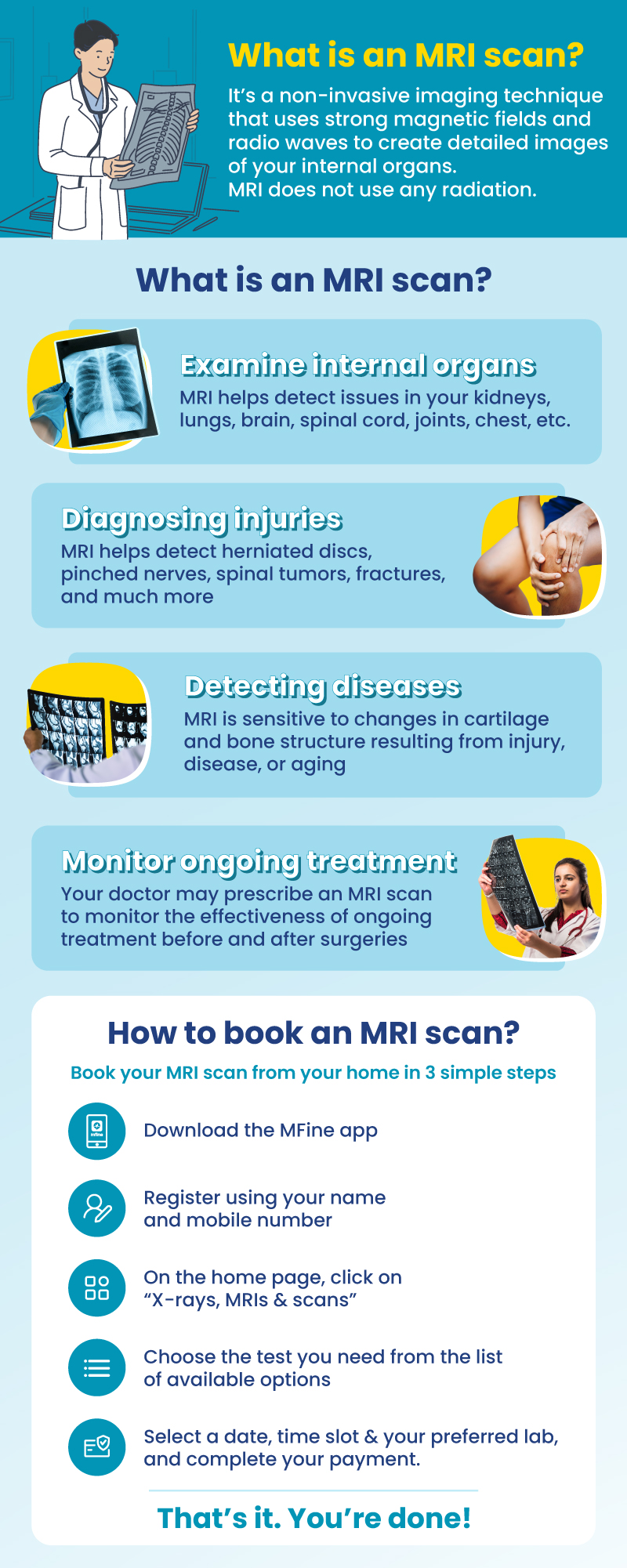
MRI Spine Scan or Magnetic Resonance Imaging Spine is a special type of scan that uses magnetic rays to create a detailed image of the spine.
MFine offers you high-quality lab options and an excellent discount of upto 50%, for your MRI Spine in Hyderabad.
MRI Scan Spine in Hyderabad by MFine
|
Generally, the market price of an MRI spine scan is above ₹6,500 but with us, you can get it for ₹3325 only.
Avail of this exclusive offer by calling us on
Or you can click on the button below for us to call you back.
Additionally, you will get a free online doctor consultation after making a booking.
Spine MRI scan costs in Hyderabad
Stay informed about the commonly available Spine MRI scans in Hyderabad and their discounted rates as mentioned below. Please be aware that prices are subject to change; feel free to reach out to us for the most current pricing.
MRI Scan Spine Cost in Hyderabad |
Offer Price |
| MRI Whole Spine Price in Hyderabad | ₹6500 |
| MRI Cervical Spine Price in Hyderabad | ₹3325 |
| MRI Dorsal Spine Price in Hyderabad | ₹3325 |
| MRI Lumbar Spine Price in Hyderabad | ₹3325 |
Dial ☏08068920280 to talk to us.
Why should I book MRI through MFine?
|
Exclusive Benefits with MFine
(1) Certified labs
Get access to over 600+ labs certified by NABL and NABH
(2) Same-day slot available
Get scans done on the same day
(3) Quick and convenient
Get reports in 12 hours and digital films in 15 – 20 minutes
(4) FREE Consultation
Post scans, consult a doctor for free to review your report
About the human Spine
A human spine comprises of the:
Vertebrae: The spine consists of 33 vertebrae, each with a unique shape and purpose. These vertebrae are categorized into five regions: cervical (neck), thoracic (upper back), lumbar (lower back), sacral (pelvic), and coccygeal (tailbone). The vertebrae are stacked on top of one another, forming the vertebral column, which surrounds and protects the spinal cord.
Facet Joints: The facet joints, also known as zygapophyseal joints, are synovial joints located between adjacent vertebrae. These joints play a vital role in facilitating spinal flexibility and movement. They are coated with cartilage, a smooth and protective connective tissue that allows the vertebrae to articulate smoothly with one another, reducing friction during various movements such as bending, twisting, and arching.
Intervertebral Disks: Nestled between each pair of vertebrae are intervertebral disks. These disks are flat, round cushions composed of a tough outer layer called the annulus fibrosus and a gel-like center called the nucleus pulposus. Intervertebral disks serve as shock absorbers, cushioning the impact of everyday activities and movements on the spine. They play a crucial role in maintaining the spine’s flexibility and overall health.
Spinal Cord and Nerves: The spinal cord is a bundle of nerves that runs through the hollow central canal formed by the vertebrae. It is an extension of the brain and serves as a vital communication pathway between the brain and various parts of the body. The spinal cord transmits sensory information from the body to the brain and relays motor signals from the brain to muscles, enabling voluntary movements.
Soft Tissues: In addition to bones and nerves, the spine relies on various soft tissues to function optimally. Ligaments are strong bands of connective tissue that attach bone to bone, providing stability to the spine and helping to maintain proper alignment. Muscles surrounding the spine play a critical role in supporting the body’s weight, controlling posture, and facilitating movement. Tendons connect muscles to bones, allowing for coordinated and controlled movements.

What are the different spine segments?
The different spine segments include:
- Cervical (neck): Comprising C1 to C7 vertebrae, responsible for neck flexibility and protecting crucial nerves.
- Thoracic (middle back): Consisting of T1 to T12 vertebrae, providing structural support and housing the chest area.
- Lumbar (lower back): Encompassing L1 to L5 vertebrae, supporting the lower back and facilitating bending and lifting.
- Sacrum: A triangular bone formed by the fusion of S1 to S5 vertebrae, connecting the spine to the pelvis.
- Coccyx (tailbone): The terminal section is composed of coccygeal vertebrae situated at the spine’s base.
Which disorders can be diagnosed using a spine MRI?
With its high precision and detailed imaging capabilities, a spine MRI aids in diagnosing diverse disorders, including:
- Arthritis, notably ankylosing spondylitis affecting the spine’s joints
- Back strains and sprains resulting from injuries or excessive physical stress
- Birth defects like spina bifida, impacting the spine’s formation
- Bone spurs, irregular bony growths affecting spinal structures
- Curvatures of the spine, encompassing scoliosis and kyphosis
- Neuromuscular diseases, including ALS (amyotrophic lateral sclerosis)
- Nerve injuries such as spinal stenosis, sciatica, and pinched nerves
- Osteoporosis, leading to weakened and brittle bones
- Spinal cord injuries involving fractures, herniated disks, and paralysis
- Spine tumors and cancerous growths in the spinal region
- Spine infections like meningitis and osteomyelitis
Why would a doctor prescribe a spine MRI?
A doctor may recommend a spine MRI to address the following medical concerns:
- Diagnosing and evaluating spinal conditions like arthritis, bone spurs, and curvatures such as scoliosis and kyphosis.
- Assessing and monitoring back injuries like strains, sprains, and fractures.
- Investigating nerve-related issues, including spinal stenosis, sciatica, and pinched nerves.
- Detecting and evaluating spinal cord injuries, herniated disks, and spinal tumors.
- Diagnosing infections like meningitis and osteomyelitis affecting the spine.
FAQs
Does a lumbar spine MRI show the colon?
No, a lumbar spine MRI does not show the colon. The primary purpose of a lumbar spine MRI is to image the lumbar vertebrae, discs, nerves, and other spinal structures.
What organs does a lumbar MRI show?
A lumbar MRI primarily shows the lumbar vertebrae, intervertebral discs, nerves, and surrounding soft tissues in the lower back region. It is not intended to visualize internal organs like the liver, lungs, or colon.
Does a lumbar MRI show the liver?
No, a lumbar MRI does not show the liver. It is specifically focused on the lumbar spine and the structures in the lower back.
Does a spinal MRI show the lungs?
No, a spinal MRI does not show the lungs. The MRI is designed to visualize the spine and surrounding structures, not the lungs or other organs outside the spine.
How long does a thoracic MRI take?
The duration of a thoracic MRI can vary depending on the complexity of the scan and the specific area being imaged. On average, a thoracic MRI may take around 30 to 60 minutes to complete.
When is a thoracic MRI needed?
A thoracic MRI is needed when there are symptoms or indications of issues in the thoracic spine (the middle part of the spine that corresponds to the chest level). It may be ordered to evaluate conditions such as thoracic back pain, spinal cord compression, herniated discs, tumors, or other thoracic spine-related problems.
What is the best scan for the thoracic spine?
For the thoracic spine, an MRI is typically the best imaging technique. MRI provides detailed images of the thoracic vertebrae, discs, spinal cord, and surrounding soft tissues, making it suitable for evaluating various thoracic spine conditions.
Can you eat or drink before a thoracic MRI?
In most cases, you can eat and drink before a thoracic MRI. Unlike some other medical imaging procedures, MRI does not require fasting. However, you may be advised to avoid heavy meals or certain foods that could cause discomfort during the scan. It is essential to follow any specific instructions provided by the healthcare facility where you will undergo the MRI.
What does a spine MRI with contrast show?
A spine MRI with contrast shows detailed images of the spinal cord, nerve roots, and surrounding tissues, highlighting areas of inflammation, infection, tumors, or other abnormalities.
How do you prepare for a thoracic MRI?
Preparing for a thoracic MRI typically involves wearing loose, comfortable clothing without any metal components. It is essential to remove any jewelry, watches, or accessories that contain metal, as they can interfere with the MRI imaging process. You may also be asked to fill out a medical history questionnaire and inform the healthcare provider about any metal implants or medical devices you may have.
What is an MRI of the sacral spine?
An MRI of the sacral spine is a specialized imaging technique that focuses on visualizing the sacrum, which is a triangular bone located at the base of the spine, just above the coccyx (tailbone).
Read more on which is better: CT scan or MRI?
Other topics you may be interested in
| For further assistance call us on ☏08068920280 |

 Call us:
Call us:


 Call
Now
Call
Now